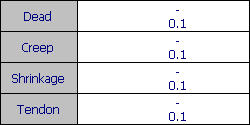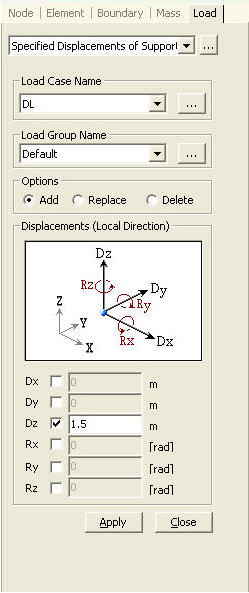 Load Case Name Load Case Name
Assign
the load case name. Click  to the right to enter additional load cases, and modify
or delete existing load cases.
to the right to enter additional load cases, and modify
or delete existing load cases.
 Load Group Name Load Group Name
Select
the desire Load Group that will include the entered Specified
Displacements of Supports data. Select "Defualt",
if a Group assignment is unnecessary. Click  to the right to add, modify or delete Load Groups.
to the right to add, modify or delete Load Groups.
 Options Options
Add: To enter new or
additional specified displacements at selected nodes assigned
with constraints
Replace: To replace
previously entered specified displacements at selected
nodes assigned with constraints
Delete: To delete previously
entered specified displacements at selected nodes assigned
with constraints
 Displacements (Local
Direction) Displacements (Local
Direction)
Enter
specified displacements with respect to the GCS or nodal
local coordinate system.
If the
nodal local coordinate system has already been defined
for specific nodes the data for the nodes are entered
with respect to the NCS.
Dx: GCS or nodal local
x-direction component of the specified displacement
Dy: GCS or nodal local
y-direction component of the specified displacement
Dz: GCS or nodal local
z-direction component of the specified displacement
Rx: Specified rotation
component about GCS or NCS X-axis
Ry: Specified rotation
component about GCS or NCS Y-axis
Rz: Specified rotation
component about GCS or NCS Z-axis
Note 1
The specified displacements are considered as load cases
in midas Gen. Thus, the specified displacements can be
combined with other load cases. Note the following when
generating load combinations in a model applied with specified
displacements.
If specified displacements are
assigned to a node, the relevant degrees-of-freedom of
the node are automatically constrained.
The
nodes assigned with specified displacements behave like
Support
even for other
load cases
that do not contain specified displacements.
In other
words, the function serves to define "Specified Displacements
of Supports" in midas.
Note
2
When the specified displacements
are entered at the specific construction stage, the load
case for the specified displacement is assigned to CS
: Dead load or CS : Erection.
But the specified
displacement is applied based not on the CS : Dead load
or CS : Erection, but on the CS : Summation. For example,
if the nodal displacements in the preceding stage are
shown in the table below and the user enter +0.1 as the
specified displacement, the specified displacement of
0.5 will be applied in order to obtain the final displacement
(Dead + Creep + Shrinkage + Tendon) of 0.1.

|

